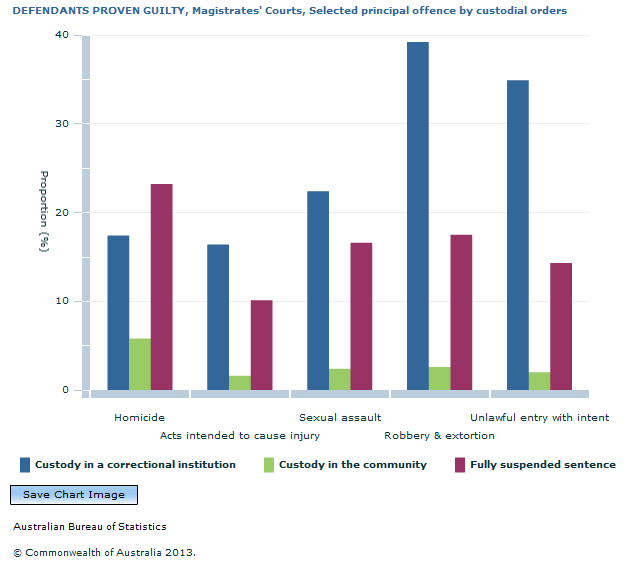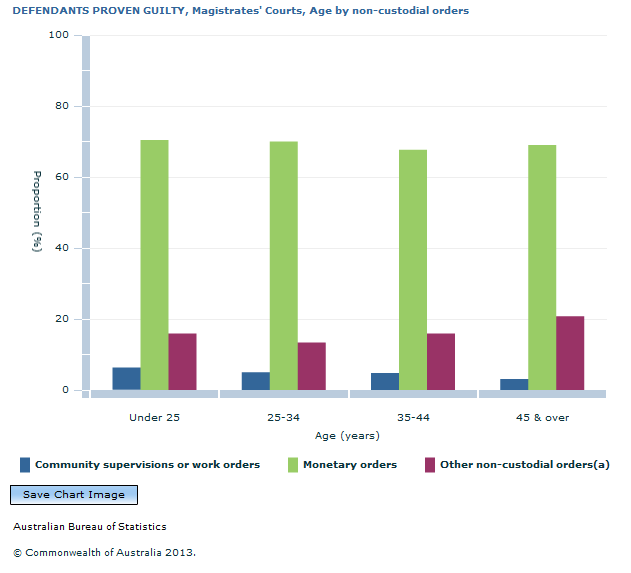4513.0 - Criminal Courts, Australia, 2011-12  Quality Declaration
Quality Declaration
ARCHIVED ISSUE Released at 11:30 AM (CANBERRA TIME) 14/02/2013
Page tools:
 Print Page Print Page
 Print All Print All
| ||||
SENTENCE OUTCOMES Sentence refers to the principal sentence a proven guilty defendant received (refer to Explanatory Notes paragraphs 45-48 for further information). Differences in sentencing result from the offence with which the defendant was proven guilty, as well as a range of aggravating and mitigating factors taken into account by the court, such as prior convictions, level of violence, whether the offender can successfully claim provocation was involved, and demonstrations of remorse. The range of sentences available also differs across states and territories. Custodial orders The most serious penalties issued for charges proven in the Magistrates' Courts are custodial sentences. In 2011-12, 9% (41,210) of guilty defendants had custodial orders imposed: 5% were sentenced to custody in a correctional institution; 4% to fully suspended sentences; and less than one percent were sentenced to custody in the community. The proportions of custodial orders handed down to defendants varied across the states and territories with the largest proportion in the Northern Territory (36%) and the smallest in Western Australia (6%). Defendants found guilty of the following offences were most likely to receive a custodial order:
The types of custodial orders issued varied across principal offences. Custody in a correctional institution was the most common principal sentence for those guilty of robbery and extortion offences (39%), followed by unlawful entry with intent (35%). Homicide and robbery and extortion were the principal offences with the highest proportions of fully suspended sentences (23% and 18% respectively).  Source(s): Criminal Courts, Australia The proportion of male defendants who received a custodial sentence was double that of women (10% and 5% respectively). Of the 35,756 males who were sentenced to a custodial order, over half (54%) were sentenced to custody in a correctional institution. In contrast, the majority of females issued with custodial orders were given fully suspended sentences (51%). Non-custodial orders The majority of guilty defendants (91% or 410,576) were given non-custodial sentences, such as community supervision or work orders, monetary orders and good behaviour bonds. This proportion has not changed since 2005-06. The most common non-custodial sentence was a monetary order, with over three-quarters (78% or 318,269) of defendants proven guilty receiving this sentence. Proportionally, monetary orders were most commonly issued to defendants guilty of traffic offences and miscellaneous offences (both 84%), public order (76%) and dangerous and negligent acts (75%). Community supervision or work orders were the most common non-custodial sentence for those guilty of unlawful entry with intent (22%), robbery and extortion (18%) and sexual assault (17%).  Footnote(s): (a) Includes good behaviour bonds, licence disqualification/suspensions/amendments, forfeiture of property and nominal penalties. Source(s): Criminal Courts, Australia There were some differences across age groups in the types of non-custodial orders issued. Defendants under 25 years had a higher proportion of community supervision/work orders (7% of defendants in this age group) than those aged 45 years and over (3%).  Footnote(s): (a) Includes good behaviour bonds, licence disqualifications/suspensions/amendments, forfeiture of property and nominal penalties. Source(s): Criminal Courts, Australia
|
||||
